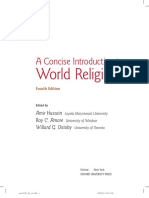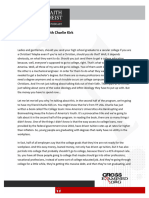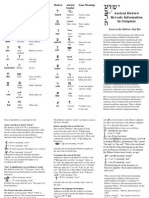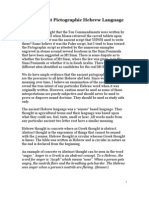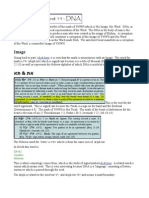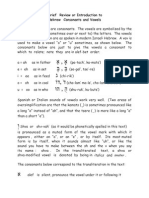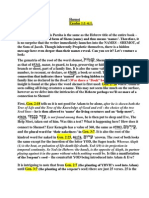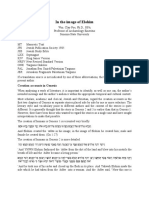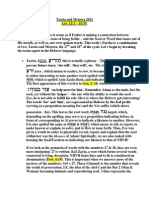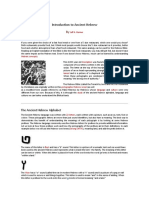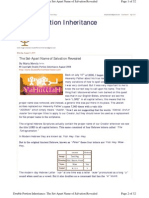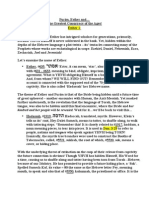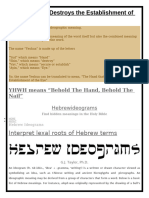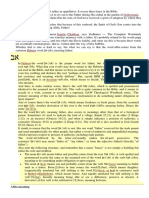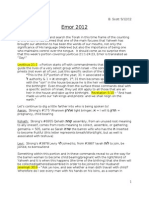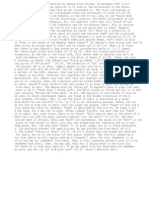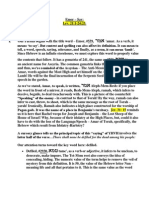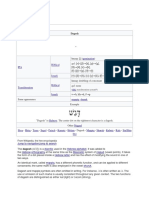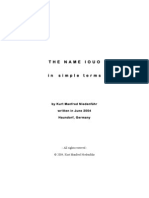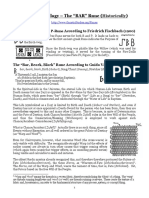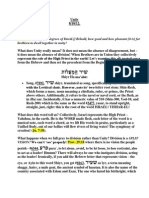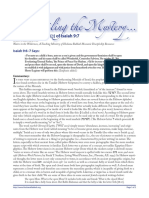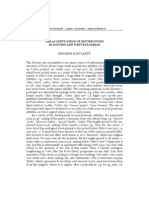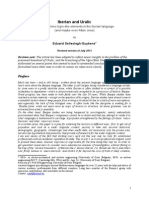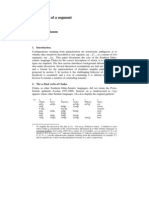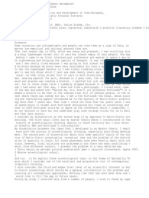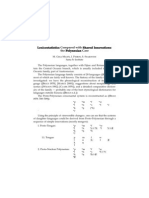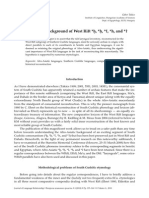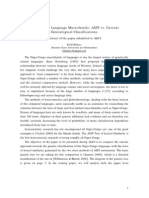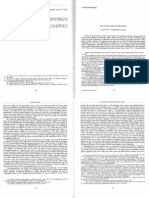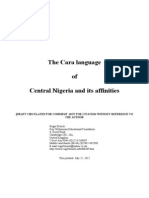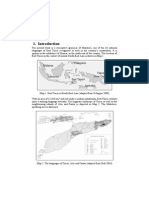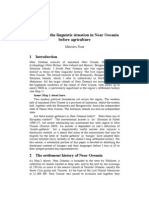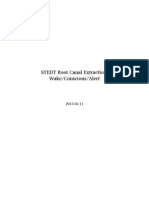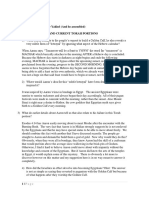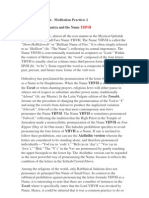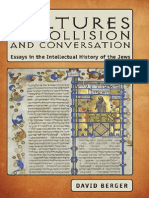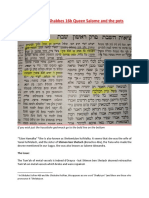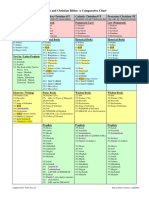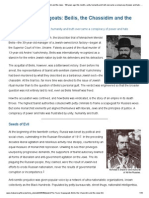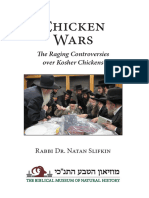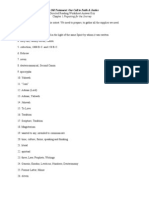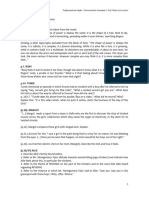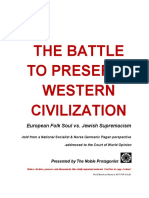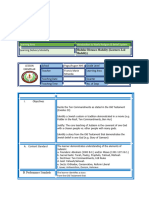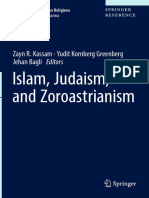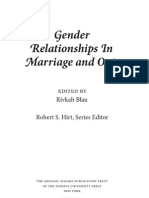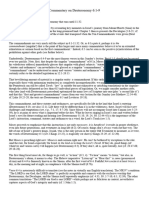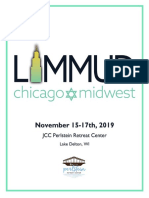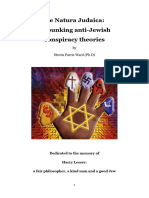Al Bayt
Al Bayt
Uploaded by
xdboy2006Copyright:
Available Formats
Al Bayt
Al Bayt
Uploaded by
xdboy2006Original Title
Copyright
Available Formats
Share this document
Did you find this document useful?
Is this content inappropriate?
Copyright:
Available Formats
Al Bayt
Al Bayt
Uploaded by
xdboy2006Copyright:
Available Formats
Al-Bayt (Alphabet), Names and Vowels
By Sha'ul bayn Yahukhenun ha'Yahudah Copyright 2012
The Way of the Most High Exalting belief in Our Father, the Most High efei (YaHUAH), through His TaNaK (falsely called Old Testament). Email followYah@gmail.com Website www.thewayofthemosthigh.ca
Al-Bayt, Names, and Vowels
What you see below is called the "al-bayt," from which came the Greek "alphabet." The root word is "al" and shows an ox followed by the shepherd staff. It is strong cattle leading. Al-Bayt" means the "Leader's House," "Strong House" or "First House." It is the starting point of all language. When learning any language, one must learn the letters first, and then move on to words and sentences. Each letter was a symbol in ancient times, like the hieroglyphics of M'tsrayim (Egypt). Actually, those hieroglyphics developed from the letters you see below. These letters are known as Early Semitic and were similar to what the people of other lands were writing in. Other scripts like the Phoenicians were similar.
Al is the word for ox, or alup. Al is "ox," meaning strong, power, leader. The extended word is "alup," often transliterated as "aluph/aluf." The additional letters "waw" and "pay" show that this is the one who speaks in leadership of cattle or his tribe in the case of Y'shr'Al (Israel). See B'rasheet (Gen.) 36:15, where it is found in the plural as "alupay." It is commonly translated as "duke" or "tribe." To this day, some people in the land of the "state of Israel" are still addressed by this term, although they soften the pay or p into a fay, as "aluf." "Ah."
Bayt. Tent, house, meaning family. "B" or "bay." Bayt is the word for "house," and this is preserved in modern Aibreet, as the bayt either makes the b (as in B'rasheet) or "bay" sound, as in Bayt/House.
b c
Gam is the word for "come," and this symbol is of the foot. It is commonly called gimmel. This is false, because for there to be a "geem" sound there would have to be a yood (y) between the gam (g) and the mem (m). The gam makes the gah sound, followed by the mem, making "gam." The extension of gam is "gamel." Some transliterate as "gamal," but there is no "ah" sound between the "mem" and "lamed." "Gamel" in the plural form as gamelim is used in B'rasheet (Gen.) 24:64. We get the English word "camel from "gamel." "G" or "gah."
Dal or Dalat. Spelled dal, lamed, is found as the basic two-letter root word meaning a door or entrance. The line over the top of the square in the letter is the lintel/upper post over the door, where the commands are to be engraved according to D'bayrim (Deut.) 6:9). See Psalm 141:3 for the phrase "ayl-dal" (over the door). The presence of the "tau" (t) at the end, as in the objective "dalat" is found in B'rasheet (Gen.) 19:6. "D"or "da."
e f
Hay. Person with arms raised, meaning Look, reveal, or breath. There are very few root words that use the hay (h) and the yood (y) making "hay." One such word is "haylal," the depiction of "praise." The letter hay itself depicts worship or works of wonder, to behold. " H" or "hay."
Oo-ah (waw commonly). There is no "w" or "v" in Aibreet. The oo-ah makes either an "ooh" sound as in "takoon" - to establish/make firm/repair (Psalm 141:2), or "oo-ah" sound as in the word "oo-ah" which means a tent peg, as seen in Sh'moot (Ex.) 27:10 (oo-ah-oo-ee, in the plural form there). Meaning to secure or hook. "Oo-ah" or "ooh."
Zayin. "Zayin" as a word is actually not found anywhere in the TaNaK. "Zayin" is a development upon the word "azan," found in D'bayrim (Deut.) 23:13. There, ei commanded that you carry a paddle/shovel on your spade/mattock/weapon, for the purpose of covering one's excrement on a journey. The "azan" or "weapon" in general was used to cut down grain stocks for nourishment. "Z" or "za." Khet. The word "khet" can be found in B'rasheet (Gen.) 9:2 and is used in the "you" form as "khetakam," meaning the "terror of you." "Khet" means terror or dread. Spelled with the fence symbol khet (kh), and the letter tau (t) for a "mark," it is to be separated or fenced off from the mark of YaH. The three downward lines, joined by two straight lines on top and bottom represent a segment of wall, brick or fence, a divide. "Kh" or "kheh."
Theth. The actual word "theth" cannot be found in the TaNaK, and is a development upon the words "thuah," being the weaver's loom that thread is spun on, as in Sh'moot (Ex.) 35:25, and the word for a rolling destruction/calamity/dirt or clay, spelled theth-yood-theth, pronounced "theeth" (like "teeth") in the famous passage of Psalm 40:3 (vs. 2 in Bibles), where the male is described as taken from the clay (theeth). The repeated "th" in "theth" is like a winding or basket, meaning to surround, contain, mud/clay. "Th" or "theh."
Yood (commonly yod). The word for an arm or a hand is yood, commonly written as "yad/yawd." If we simply progress from the y sound to the dalat sound, we have y'd. Not a hard "a" sound, but closer to "uh." I suppose it could be written as "yuhd." It is spelled yood, dalat, and first appears in B'rasheet (Gen.) 3:22. Arm and closed hand, meaning to work or throw. "Y" or "ee" Kawp. Palm of a hand or sole of a foot, as seen in B'rasheet (Gen.) 8:9 where the dove could not rest the kawp (sole) of its foot from the flood waters. Commonly kaph/kaf as modern Masoretic does not pronounce the letter pay (p) but as fay (f). Also used as the word for the hollow of a rock (Ayub (Job) 30:6). Open hand, meaning bend, open, or
allow.
"K" or "ka."
Lamed. "Lamed" is the word for goading or leading a flock. It is the picture of a shepherd's goad or staff. It is first found as the word for teaching, leading in truth, in D'bayrim (Deut.) 4:1. All the words which ei teaches (m'lamed). Shepherd staff, meaning teach, yoke, bind. "L" or "la." Mem. "Mem" is what this letter is called, not that there is a word "mem" in Scripture, but it is the symbol of "meyim," being the word for water, spelled mem, yood, mem (B'rasheet (Gen.) 1:2 - ha'meyim). To shorten "meyim," this became "mem." One related word is "memed," being a "measurement" (Ayub (Job.) 38:5). Some of the earliest measurements of weight were done using water. Water, meaning chaos as in the creation account, mighty, or blood. "M" or "meh."
Noon. Sprout, meaning heir, continual, perpetual. Hence the concept of seed or sperm. "Noon" can be found in Psalm 72:17, stating that the Name of efei will endure and continue (y'neen) forever. It is used as a proper name for Yahushai (Joshua), son of Noon (nun). "N" or "noo (like new)."
Samek. This word first appears in B'rasheet (Gen.) 27:37 where Aishu (Esau) is sustained (samek'tayu) with wine (tee-rash). This picture letter named samek is that of a crutch or support. It is also used as thorn, meaning grab, hate, protect. It is used as to lay hand on the head of the offerings for example in Wa'y'qora (Lev.) 4:4. There is actually a Scriptural name being "SamekYahu," one that is "supported of YaH." "S" or "sa."
Ayin. "Ayin" is obviously where we get the English word "eye" from, and it is obvious as to the picture letter meaning. This letter is sadly not pronounced very accurately at all in modern Aibreet (Hebrew). They equate the ayin with al in making it either an "ah" or "oh" sound. Don't ask me where they get the "oh" out of "ayin" from. Interestingly enough, the word "ayin" is the word for "fountain" in B'rasheet (Gen.) 16:7. The ancients thought of a well/spring/fountain as being the "eye" of a desert, providing tears/water for people. It is here that Haygar (Hagar) was SEEN of efei (YaHUAH) and named the well as a place where He had seen her. Eye, meaning watch, guard, fountain. "Ai." Pay. B'rasheet (Gen.) 4:11 first uses this word in the feminine pay'ha for "her mouth," referring to the ground that swallowed the blood of Haybayl (Abel). Did you know that the sword has two edges/mouths (payoot)? It is true. One of my favourite stories is that of Ahood who made a knife/dagger/sword of such payoot (edges). Mouth, meaning blow, scatter, edge. "P" or "pay." Tsawdee. Actually "tsad" at its basic root, is the word for a design, in terms of
trapping or lying in wait, which is done beside something. In the case of the ark that Nuakh (Noah) was instructed to build, there was a window in the side (tsad) of the ark (B'rasheet (Gen.) 6:16). In Dani'Al (Daniel) 6:4 the word is used as an accusation, where the enemies of Dani'Al (Daniel) conspired and sought to find something against (tsad) him to trap him. "Tsada" is the word for a true design, and is used as the word truth in Dan. 3:14 when the sovereign asked the Aibreem (Hebrews) if the accusation was true. being the word for "hunt" or "destroy." Meaning chase, snare, or hunt. "Ts" or "tsa."
Qop. Commonly pronounced "qof," since modern Aibreet (Hebrew) does not pronounce the letter pay as "p" but as "f." This symbol represents the sun at the lands end, meaning spherical or time. It is actually the equalling of day and night, which happens at evening or at the equinoxes of spring and fall. This is referred to as "taqopat" in Sh'moot (Ex.) 34:22. Clearly, this is a circuit or complete cycle of the sun. "Q" or "qoh."
Rawsh (commonly Resh). The first appearance of this term is the head-waters mentioned in B'rasheet (2:10) (mentioned in the plural as 4 rashim). Head, chief, meaning first, top, beginning. The symbol speaks for itself. It is used of mountaintops in B'rasheet (Gen.) 8:5. "R" or "Ra." Shin. This symbol is obvious as reference to the two front teeth, meaning to press, eat, or two (sh'ney). See B'rasheet (Gen.) 49:12 for example of teeth. In 1 Sh'mu'Al (Sam.) 14:4 it is used as a descriptive for a sharp (shin) rock/crag. "Sh" or "shih."
s t
Tau. The font here does not allow for two crossed angled lines, as it is found originally in archaeology. The crossed sticks were used as a sign, mark or monument. This is in no way related to an upright cross as in the Christian symbol, and such a symbol is foreign to the TaNaK (OT). The word "ta-oo/tau" is used to mark off or designate a place in B'medbayr (Num.) 34:8. Interestingly, it is used to describe the antelope, because of its marks/stripes, in D'bayrim (Deut.) 14:5. "T" or "ta." Here is the keyboard code for Al-Bayt in Pictograph Script (Early Semitic) if people want to use it in their documents:
qq ww ee rr tt yy uu ii oo pp aa ss dd ff gg hh jj kk ll zz xx cc vv bb nn mm
In order of 3 rows as on your keyboard as above: (q)Qop (e)hay (r)rawsh (t)tau (y)tsawdee (u)theth (i)yood (o)ayin (p)pay (a)Al (s)shin (d)dalat (f)waw (g)ghayin (h)khet (k)kap (l)lamed (z)Zayin (x)Samek (c)Gam/Gimmel (b)Bayt (n)Noon (m)Mem
While there are no writings of Scripture that are written in this Early Semitic font for us to read, it is helpful to use these fonts out of reverence for the Name of the Almighty. And we can always transliterate our modern Aibreet (Hebrew script) TaNaK (OT) back into this ancient picture language to help us understand words and names. It is also helpful for us to see how the original writing of Scripture was written using letterpictures. When you are reading Scripture in the modern Aibreet (Hebrew script) you will be able to put those letters back into the ancient font to see what the word pictures. Now here is a breakdown of a few examples regarding the Name of the Most High and a few other names in Scripture: 1. 2. 3. 4.
5. Yahushua/Yeshua/J.C whom we do not believe in). Notice the ayin at the end, indicating "ai" or "eye." The very first Name that you see under number 1 is YaH. You will find this in modern script in T'haylah (Psalm) 68:5 (vs. 4 in most Bibles, vs. 5 in the original text of the TaNaK). Only since the 15th century and the Masoretic scribes has it been thought that the Name of the Most High is Yehovah. Out of this came a movement of Messianics who have come to believe that the Name of the Most High is Yehuweh. It is a combination of Yehovah and Yahweh. So it is evident that there are different beliefs out there concerning the Name of the Almighty. But what is the truth? The truth is that the Name of the Most High was known to be YaH from ancient times until Galatinus penned the famous transliteration of Yehovah. Of course, Galatinus was a Christian who followed the method of the Masoretic scribes. Long before Galatinus, the Masoretic scribes decided to hide the Name of the Almighty so that it wouldnt be blasphemed. They decided to place vowel points within the Name of the Most High based upon a method of thinking that they devised. They added the vowel of e from Elohim between the "yood" (Y) and the hay (H). They added the vowel of o which is common to both ElOhim and "AdOnai" in between the two hays (h). They added the vowel of a from Adonai between the waw (W) and the hay (H). And so we ended up with YeHoWah or YeHoVah. We do not use "Elohim" and "Adonai," but "Alahym" and "Adani." See our Ancient Aibreet Terminology pdf. But Galatinus and the Masoretic scribes forgot to mess up the rest of Scripture. They didnt change YaH to Yeh in the vowel pointing in other places of Scripture, such as the phrase haylaluYaH (commonly halleluiah). Rather, they vowel-pointed YaH in that phrase exactly as we have done throughout this article and our writings. And when the translators put Scripture into English, they maintained the pronunciation of YaH and other names which had YaH in it, like IsaIAH, JeremIAH, etc. And while those names are not transliterated properly as YaHU like "Y'shaiYahu (Isaiah)," they still give evidence that the Name of the Most High originally began with YaH!
ei = Yah fei = Yahu edfei = Yahudah efei = Yahuah or "YaHUAH" ofsfei = Yahushuai the son of Nun (Not to be confused with
There is also evidence from the Arabic language that attests to the Name of YaH. Believers in YaH are known in Arabic as al-yahud. Arabic is very similar to Aibreet (Hebrew language), and naturally so, since Y'sh'mai'Al (Ishmael) was the brother of Y'tsakheq (Isaac). A lot of their customs, such as the slaying of the lamb each year at Mecca, also correspond to Scriptural truths that were handed to Y'tsakheq (Isaac) and the twelve tribes of Y'shrAl (Israel). It is also noted that the Murashu texts of the Aibreet (Hebrew Scriptures) used the form of Yahu rather than Yeho as well. Thus, even in the exile to B'bayl (Babylon), Y'shr'Al (Israel) maintained the Yahu pronunciation. There are tons of other archaeological finds that correspond to the Yahu pronunciation, such as what Saggs revealed in his book on The Babylonians. The correct Name of the Most High ignores the Masoretic scribal vowel points. It starts with YaH. On top of the Name of YaH, contained in the phrase hallelu-YaH, there is the extra waw added to make YaHU. YaHU is contained in the names of Scriptural people as shown earlier. Finally, our ultimate answer is found in the name of the tribe of Yahudah, known as Judah in modern English versions. Yahudah received his name from his mother when she said that she would praise the Most High (B'rasheet (Gen.) 29:35). The original word is a-udah, meaning gratefully praise as The Stone Edition Tanach translates in English (pg. 71). When connected to the Name of the Most High YaH we get YaHUDaH. Ultimately, this means to praise or worship ei (YaH). What is the significance of Yahudah in comparison with the Name of the Most High? Well the only difference between the two names, as seen in the modern script, is the letter d or dalat. See examples 3 and 4 above under our the breakdown of the Name of YaH, Yahudah, and other names like Yahushai (Joshua, as spelled without the oo-ah (waw) between the shin and ayin, which is mostly the case in Scripture). Numerous Scriptural scholars have seen the connection between existence, which is hayah, the name of Yahudah and the Name of Yahuah. T.J. Meek, Clover and Otto Proksch to name a few. Amongst a number of counties today, the pronunciation of Yahuah remains preserved. Rarely do nationalities use the pronunciation of Yehuweh, Yahweh, or Yehovah. We will speak now regarding the name of Yahushai the son of Nun, as seen under point number 5. In most English translations, this name is transliterated as Joshua. However, you will notice that all concordances attest that the original is Jehoshua. It is spelled in the modern Aibreet (Heb. script) as [Xwhy, and in the older script as "osfei." Most concordances will tell you that it is pronounced as Jehoshua. But of course, there never was a Jehoshua because there was no Strongs concordance back then. And Strongs concordance is biased towards the use of Jehovah. So, every time you come to a name in Scripture that starts with Jeho, you can change it back to Yahu. There are several versions of Scripture which have rightly done that. Thus, the original is Yahushai, the son of Nun. (see Yahushai (Josh.) 1:1). His name combines the Name of ei (Yah) and the word for deliverance which is y'shuai'h (see B'rasheet (Gen.) 49:18). Thus, Yahushai literally speaks that YaH is our deliverance. Not Yahushua/Yeshua/Jesus son of "Joseph and Mary" as the New Testament proclaims. This is seen in how the Most High delivered His people from M'tsrayim (Egypt). Behold, the Mighty One is my deliverance (y'shuaiti). I will trust,
and not fear. For ei (YaH), efei (YaHUAH) is my strength and my song. And He is my deliverance (lyeshuai'h) (Y'shaiYahu (Isa.) 12:2). Indeed, we must proclaim that He alone is our deliverance. That is our message here. We pray that this has been helpful to understanding Aibreet (Hebrew script) picture letters, vowels and the names of people in Scripture who had the Name of the Most High in their own names. Below is a chart which shows the modern Aibreet (Hebrew script) letters, and a chart that shows the vowels can be found under the modern script in modern-day versions of the TaNaK (OT). As stated before, one should use modern Aibreet (Hebrew) to get the hang of reading the TaNaK for themselves in the modern Aibreet (Hebrew) text. Then they can begin to restore the text back to the ancient using a more simple pronunciation for each letter as shown in our Al-Bayt. We do not promote or use modern Aibreet (Hebrew) niqud/vowel-pointing.
a
b g d h w z x j y k l m n s [ p c q r v t
Al Bayt Gam Dalat Hay Oo-ah Zayin Khet (Chet) Theth Yood Kap Lamed Mem Noon Samek Ayin Pay Tsawdee Qop Rawsh Shin Tau
a b g d h w or v in modern Masoretic. See above for correct pronunciation. z kh or ch t y k l m n s a p ts q r sh t Final pay is @ Final mem is ~ Final nun is ! Final kap is &
Final tsawdee is #
Understanding Niqud (Vowel-points). The following is purely to express how to read modern Masoretic vowel-pointing. Mark English Vowel Equivalent and Sound I, ee as in machIne. Khiriq, dot under letter Qubbuts, dot top left of U, oo sound, as in Letter tUne. Patakh, line under letter A, ah sound, as in pAw. Segol, three dots under E, eh sound, as in letter. Elephant. Tsere, two dots under letter. E, eh sound, as in grEy or lay. Qamats, T-shape under letter. Shva, : under letter. A, ah sound, as in pAw. When shva is used under first letter of a word, it is a soft e, like in hElp. When in the middle of a word, it indicates silence, as in shva. Indicates that you would use the normal use of the letter. For example, when used with the Waw or Vav, it would be Waw (oo or w sound) rather than vav (v sound). When used with Pay (or pay), it would be p rather than f (fay) sound. O, as in Olam or mOle. Pronounce the Shin as s rather than sh (But I think this is more of a falsehood than truth. Hence, Sh'then rather than Satawn. Pronounce the Shin as sh rather than s.
Shuruq, dot to the left and middle of the letter.
Kholam or kholam malay, dot above letter, in middle. Letter Shin with a dot an top left.
Letter Shin with a dot at top right.
Khataf segol or khataf When the shva ( : ) is placed under a letter with the patakh, combines the three dots and the : under the letter, segol (three dots) or the line or the line and the : under the (patakh), the result is a khataf letter. segol or khataf patakh. The shva is telling you that the segol or patakh is to be softened in sound, just like the shva or hardly heard e in sheva. Khataf qamats, combines When the shva ( : ) is the T-shape and the : under placed under a letter with the the letter. qamats (T shape), the result is a khataf qamats. Like the khataf segol and khataf patakh, it indicates a softening of the sound, like the hardly heard e in sheva (shva).
SOURCES The Stone Edition Tanach. Brooklyn, New York: Mesorah Publications, 2007. JPS Hebrew-English TaNaKh. Philadelphia, USA: The Jewish Publication Society, 1999. Saggs, H.W.F. The Babylonians. London: St. Edmundsbury Press, 2002. 6th Printing.
You might also like
- A Concise Introduction To: World ReligionsDocument672 pagesA Concise Introduction To: World ReligionsDeep SukhanNo ratings yet
- Chalie Kirk The College Scam 10-27-22Document20 pagesChalie Kirk The College Scam 10-27-22ipy06officialNo ratings yet
- Swart, Jacobus G.: "Otiot: SacredSigns"Document24 pagesSwart, Jacobus G.: "Otiot: SacredSigns"Jacobus Swart94% (16)
- Paul's 5 Defenses (Acts 22-26)Document1 pagePaul's 5 Defenses (Acts 22-26)Chan Mei Pheng100% (2)
- Hebrew VowelsDocument271 pagesHebrew VowelsHaileleul Kassa100% (1)
- Teaching English To Hebrew Speakers: IdiomsDocument4 pagesTeaching English To Hebrew Speakers: Idiomsisrael_cohen_3No ratings yet
- Alef BeitDocument2 pagesAlef BeitAbanoubNo ratings yet
- The Ancient Pictographic Hebrew Language1Document10 pagesThe Ancient Pictographic Hebrew Language1Tratul AbidNo ratings yet
- Lashawan QadashDocument10 pagesLashawan QadashYanzhiel AshimaNo ratings yet
- Mark OF THE BEASTDocument183 pagesMark OF THE BEASTgrb123xb123100% (2)
- Nicholas Gonner and The JewsDocument5 pagesNicholas Gonner and The JewsFausto GardiniNo ratings yet
- Writings of Bill HendrickDocument60 pagesWritings of Bill Hendrickrarmandjr8474No ratings yet
- By Sha'ul Ben YahukhananDocument8 pagesBy Sha'ul Ben YahukhananlarthNo ratings yet
- Kabbala GenesisDocument5 pagesKabbala GenesiscirrconniNo ratings yet
- B Letters MethodDocument4 pagesB Letters MethodCathrina AlbestNo ratings yet
- My Fathers HouseDocument7 pagesMy Fathers HouseRaphael888No ratings yet
- Was There A "Book" Before MosheDocument4 pagesWas There A "Book" Before MosheDavid MathewsNo ratings yet
- ImportancefathersonsnamesDocument5 pagesImportancefathersonsnamesRex Abas100% (1)
- in The Name of The FatherDocument22 pagesin The Name of The Fatherapi-231781675No ratings yet
- In The Image of ElohimDocument15 pagesIn The Image of ElohimWilliam PoeNo ratings yet
- Tazria, תַזְרִיעַ/Metzora, מְּצֹרָעDocument6 pagesTazria, תַזְרִיעַ/Metzora, מְּצֹרָעDavid MathewsNo ratings yet
- The Ancient Hebrew AlphabetDocument7 pagesThe Ancient Hebrew AlphabetArnoldo OrtizNo ratings yet
- The Entire Story of Jesus Stolen From Kemet EgyptDocument23 pagesThe Entire Story of Jesus Stolen From Kemet Egyptmario195mz83% (6)
- Set Apart Name of Salvation RevealedDocument30 pagesSet Apart Name of Salvation Revealedapi-231781675No ratings yet
- BereishitDocument6 pagesBereishitDavid Mathews100% (1)
- Some Notes On The Word "Elohim": 1) "Elohim" Does Not Mean "Shining Ones" or "Luminous Ones,"Document5 pagesSome Notes On The Word "Elohim": 1) "Elohim" Does Not Mean "Shining Ones" or "Luminous Ones,"WickedWitchyNo ratings yet
- HebrewDocument16 pagesHebrewMiriam De PamphilisNo ratings yet
- Purim - The Great Conspiracy! 2012Document7 pagesPurim - The Great Conspiracy! 2012RF / HebrewNationNo ratings yet
- Biblical Hebrew NamesDocument7 pagesBiblical Hebrew NamesMickey CroweNo ratings yet
- Hebrew, #5475, Means Counsel, Confidentiality That Comes Only by Intimacy!Document9 pagesHebrew, #5475, Means Counsel, Confidentiality That Comes Only by Intimacy!David MathewsNo ratings yet
- Introduction To Hebrew Healing LettersDocument11 pagesIntroduction To Hebrew Healing LettersKoop Da VilleNo ratings yet
- Hebrew Ideograms Find Hidden Meanings in the Holy BibleDocument18 pagesHebrew Ideograms Find Hidden Meanings in the Holy Biblebriancharles7777777No ratings yet
- Names of God in JudaismDocument13 pagesNames of God in Judaismangphone95No ratings yet
- Genesis 3 CommentariesDocument17 pagesGenesis 3 Commentariesabraham rendonNo ratings yet
- Comentarii Contemporane - Cain Si Abel (Fc. 4, 1-5)Document39 pagesComentarii Contemporane - Cain Si Abel (Fc. 4, 1-5)stelianpascatusaNo ratings yet
- Nombres de Dios en La BibliaDocument49 pagesNombres de Dios en La BibliashalomlyNo ratings yet
- Emor, אֱמֹרDocument6 pagesEmor, אֱמֹרDavid Mathews100% (1)
- Bamidbar, בְּמִדְבַּרDocument7 pagesBamidbar, בְּמִדְבַּרDavid Mathews100% (1)
- SheolHades What Is ItDocument4 pagesSheolHades What Is ItJustinian FiloteosNo ratings yet
- Emor, אֱמֹרDocument6 pagesEmor, אֱמֹרDavid Mathews100% (1)
- DageshDocument5 pagesDageshGee PennNo ratings yet
- Little Guy in The EyeDocument200 pagesLittle Guy in The EyeAmy Pollock0% (1)
- The Name Iouo in Simple TermsDocument19 pagesThe Name Iouo in Simple Termsdito100% (3)
- GnosticRunes-Notes BAR Historically1fDocument5 pagesGnosticRunes-Notes BAR Historically1fdonbuchwalterNo ratings yet
- WALKER, L. L. Language of AmosDocument13 pagesWALKER, L. L. Language of AmosFilipe AraújoNo ratings yet
- The Syriac of The Maronite Qorbono 2Document8 pagesThe Syriac of The Maronite Qorbono 2Jeferson Martins rodriguesNo ratings yet
- Construct Chains: Unit 12Document18 pagesConstruct Chains: Unit 12Márcio de CarvalhoNo ratings yet
- The Vowels' Symbolism in Archaic Hymns - Notes To The Vowels in de Elocutione of DemetriusDocument10 pagesThe Vowels' Symbolism in Archaic Hymns - Notes To The Vowels in de Elocutione of DemetriusRichter, JoannesNo ratings yet
- DevarimDocument7 pagesDevarimDavid MathewsNo ratings yet
- Pronunciation Guide To Sephiroth Letters and Divine Names PDFDocument6 pagesPronunciation Guide To Sephiroth Letters and Divine Names PDFcyberdemon08No ratings yet
- Brethren To Dwell Together in Unity!: Song, #7892Document6 pagesBrethren To Dwell Together in Unity!: Song, #7892David MathewsNo ratings yet
- Let Us Make Them According To Our LikenessDocument3 pagesLet Us Make Them According To Our LikenessKIM HARRNo ratings yet
- Preface 2nd Edition, Rev 1Document11 pagesPreface 2nd Edition, Rev 1Patricio Piedra100% (1)
- Welcome To Mastering NT Greek: by Ted Hildebrandt © 2003 Baker AcademicDocument52 pagesWelcome To Mastering NT Greek: by Ted Hildebrandt © 2003 Baker AcademicErick Javier Florez100% (1)
- Notes To Gerald Massey's Ancient EgyptDocument6 pagesNotes To Gerald Massey's Ancient EgyptRichter, Joannes100% (1)
- Closed - Mem en Isaias 9Document2 pagesClosed - Mem en Isaias 9Roxana BarnesNo ratings yet
- The Rainbow LanguageDocument7 pagesThe Rainbow LanguageDavid Mathews100% (1)
- Above Torah: What the New Testament Truly Reveals about "the Law"From EverandAbove Torah: What the New Testament Truly Reveals about "the Law"No ratings yet
- A Is for Abandon: An English to Biblical Hebrew Alphabet BookFrom EverandA Is for Abandon: An English to Biblical Hebrew Alphabet BookNo ratings yet
- The Accentuation of Neuter Nouns in Slovene and West BulgarianDocument7 pagesThe Accentuation of Neuter Nouns in Slovene and West Bulgarianxdboy2006No ratings yet
- Iberian and Uralic 12julyl2013Document18 pagesIberian and Uralic 12julyl2013xdboy2006No ratings yet
- Lowenstamm FS DresslerDocument10 pagesLowenstamm FS Dresslerxdboy2006No ratings yet
- DisertaceDocument287 pagesDisertacexdboy2006No ratings yet
- Lexicostatistics Compared With Shared Innovations: The Polynesian CaseDocument32 pagesLexicostatistics Compared With Shared Innovations: The Polynesian Casexdboy2006No ratings yet
- jlr2010 4 (135 166)Document32 pagesjlr2010 4 (135 166)xdboy2006No ratings yet
- Niger-Congo Language Macrofamily: ASJP vs. Current Genealogical ClassificationsDocument3 pagesNiger-Congo Language Macrofamily: ASJP vs. Current Genealogical Classificationsxdboy2006No ratings yet
- Hugjiltu Comparison of Turkish and MongolianDocument60 pagesHugjiltu Comparison of Turkish and Mongolianxdboy2006No ratings yet
- Rubio 2002 On A Recent Volume of Mari Letters RV ARM 28 AuOr 20Document4 pagesRubio 2002 On A Recent Volume of Mari Letters RV ARM 28 AuOr 20xdboy2006No ratings yet
- Cara WordlistDocument31 pagesCara Wordlistxdboy2006No ratings yet
- Dalrymple NikolaevaDocument263 pagesDalrymple Nikolaevaxdboy2006No ratings yet
- BookpartDocument35 pagesBookpartxdboy2006No ratings yet
- Bailey 97 V 1Document401 pagesBailey 97 V 1xdboy2006No ratings yet
- Ross HuntGath PPR W Maps-LibreDocument29 pagesRoss HuntGath PPR W Maps-Librexdboy2006No ratings yet
- 1 1 4 20130211 1 DraftDocument81 pages1 1 4 20130211 1 Draftxdboy2006No ratings yet
- CaucprefDocument242 pagesCaucprefxdboy2006No ratings yet
- Timeline of The ExodusDocument6 pagesTimeline of The ExodusJake WilsonNo ratings yet
- Scroll To Scroll-Vayakhel2016Document29 pagesScroll To Scroll-Vayakhel2016api-204785694No ratings yet
- Chariot Ineffable NameDocument5 pagesChariot Ineffable NameblckcldsNo ratings yet
- Cultures in Collision and Conversation Essays in The Intellectual History of The JewsDocument385 pagesCultures in Collision and Conversation Essays in The Intellectual History of The JewsDijana100% (2)
- Shabbat 16BDocument6 pagesShabbat 16BJulian Ungar-SargonNo ratings yet
- Israelite Festivals and Christian Church BRI - Ángel Manuel RodríguezDocument21 pagesIsraelite Festivals and Christian Church BRI - Ángel Manuel RodríguezEdmundo Aquino100% (1)
- Heb-Xn-Bibles ChartDocument2 pagesHeb-Xn-Bibles ChartJhada BainNo ratings yet
- Rosh Hashanah To-Go - 5779Document49 pagesRosh Hashanah To-Go - 5779todah18No ratings yet
- The Tsar's Scapegoats: Beilis, The Chassidim and The JewsDocument16 pagesThe Tsar's Scapegoats: Beilis, The Chassidim and The JewsEli Leib RubinNo ratings yet
- TỔNG ÔN TA ĐỀ 2Document3 pagesTỔNG ÔN TA ĐỀ 2Quang LêNo ratings yet
- Chicken Wars A5Document32 pagesChicken Wars A5kollelmenachemtzionNo ratings yet
- Download ebooks file Human Behavior in the Social Environment: Perspectives on Development and the Life Course all chaptersDocument41 pagesDownload ebooks file Human Behavior in the Social Environment: Perspectives on Development and the Life Course all chapterschumaovernql100% (3)
- Chapter One Review AnswersDocument2 pagesChapter One Review AnswersalexdiceaNo ratings yet
- The PowerDocument13 pagesThe PowerCamila PisaniNo ratings yet
- The Battle To Preserve Western CivilizationDocument1,192 pagesThe Battle To Preserve Western CivilizationxuyeNo ratings yet
- Religion COT Lesson ExamplerDocument3 pagesReligion COT Lesson ExamplerFrancis marie MirandaNo ratings yet
- The Jewish Encyclopedia Vol X 1905Document326 pagesThe Jewish Encyclopedia Vol X 1905Peter James ClarkNo ratings yet
- Bava Metzia 089 PDFDocument2 pagesBava Metzia 089 PDFmasmidNo ratings yet
- Encyclopedia of Indian Religions Zayn R. Kassam Yudit Kornberg Greenberg Jehan Bagli Islam Judaism and Zoroastrianism 2018 Springer NetherlandsDocument841 pagesEncyclopedia of Indian Religions Zayn R. Kassam Yudit Kornberg Greenberg Jehan Bagli Islam Judaism and Zoroastrianism 2018 Springer Netherlandsmariasil100% (1)
- UntitledDocument319 pagesUntitledoutdash2No ratings yet
- Commentary On Deuteronomy 6Document2 pagesCommentary On Deuteronomy 6Tagupakiller YTNo ratings yet
- Learn Zohar Eng 1Document164 pagesLearn Zohar Eng 1gabrielmotocNo ratings yet
- Limmud Chi MW 2019 Update Program BookDocument36 pagesLimmud Chi MW 2019 Update Program Bookapi-405912150No ratings yet
- LESSON 3 - JudaismDocument5 pagesLESSON 3 - JudaismVictor Noel AlamisNo ratings yet
- LeviticusDocument2 pagesLeviticusares.ultimate.collectionNo ratings yet
- De Natura Judaica Debunking Anti Jewish Conspiracy TheoriesDocument371 pagesDe Natura Judaica Debunking Anti Jewish Conspiracy Theoriesbutthugs1534No ratings yet
